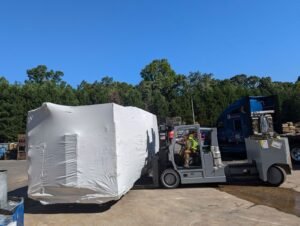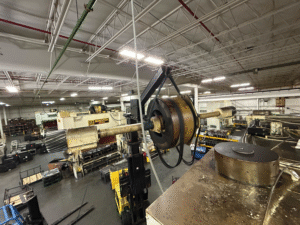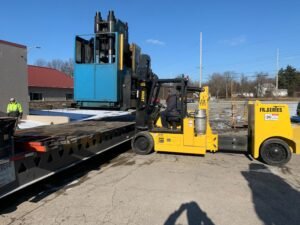The pharmaceutical industry is one of the most regulated and complex sectors in the world, requiring stringent adherence to safety, hygiene, and efficiency standards. Fabrication solutions play a crucial role in meeting these demands, ensuring that pharmaceutical facilities and equipment are designed, manufactured, and maintained to the highest standards. This article explores the various fabrication solutions that are vital to the pharmaceutical industry, covering topics such as materials, equipment, processes, and quality control.
The Importance of Fabrication in the Pharmaceutical Industry
Fabrication is the process of constructing industrial products from raw materials. In the pharmaceutical industry, this involves creating a wide range of products, from small components to large machinery, that are essential for the production, processing, and packaging of medications. The importance of fabrication in this industry cannot be overstated, as it directly impacts the quality and safety of pharmaceutical products.
Compliance with Regulatory Standards
One of the primary reasons fabrication is so critical in the pharmaceutical industry is the need for compliance with regulatory standards. The U.S. Food and Drug Administration (FDA), European Medicines Agency (EMA), and other regulatory bodies enforce strict guidelines for the design and construction of pharmaceutical equipment and facilities. Fabrication solutions must ensure that all products meet these guidelines to avoid costly fines, product recalls, and potential harm to patients.
Ensuring Product Quality and Safety
Fabrication solutions are integral to maintaining the quality and safety of pharmaceutical products. Poorly fabricated equipment can lead to contamination, inaccurate dosing, and other serious issues. High-quality fabrication ensures that equipment operates efficiently and reliably, reducing the risk of product defects and ensuring that medications meet the necessary standards for purity, potency, and stability.
Materials Used in Pharmaceutical Fabrication
The selection of materials for fabrication in the pharmaceutical industry is a critical decision that affects the durability, cleanliness, and functionality of the final products. The materials must withstand harsh chemical environments, frequent cleaning, and sterilization processes while maintaining their integrity over time.
Stainless Steel: The Material of Choice
Stainless steel is the most commonly used material in pharmaceutical fabrication due to its excellent resistance to corrosion, high strength, and ease of cleaning. Specifically, 316L stainless steel is preferred for its low carbon content, which enhances its resistance to sensitization and corrosion. This material is used in a wide range of applications, including the fabrication of tanks, piping, workbenches, and other critical equipment.
Other Materials: Glass, Plastics, and Alloys
While stainless steel is the dominant material, other materials are also used in specific applications. For instance:
- Glass is often used in bioreactors and other equipment where visibility of the process is required.
- Plastics such as polypropylene and polytetrafluoroethylene (PTFE) are used for tubing, gaskets, and seals due to their chemical resistance and flexibility.
- Specialized alloys may be used in situations where enhanced resistance to extreme temperatures or chemical environments is needed.
Material Compatibility and Cross-Contamination Prevention
In pharmaceutical fabrication, it is crucial to ensure that the materials used are compatible with the products being manufactured. Incompatible materials can lead to cross-contamination, which can compromise the safety and efficacy of medications. Fabricators must carefully select materials that will not react with or degrade when exposed to the chemicals and compounds used in pharmaceutical production.
Fabrication Processes for Pharmaceutical Equipment
The fabrication of pharmaceutical equipment involves a variety of processes, each of which must be carefully controlled to ensure the final product meets the industry’s stringent standards. These processes include cutting, welding, machining, and finishing, among others.
Cutting and Shaping
The first step in the fabrication process is cutting and shaping the raw materials into the desired forms. This can be done using various methods, including laser cutting, waterjet cutting, and mechanical cutting. Laser cutting is often preferred for its precision and ability to produce clean edges, which is essential in applications where hygiene is critical.
Welding and Joining
Welding is a key process in the fabrication of pharmaceutical equipment, as it allows for the creation of strong, leak-proof joints between metal components. Various welding techniques can be used, including TIG (tungsten inert gas) welding, which is favored for its precision and ability to produce clean, high-quality welds. Proper welding practices are crucial to prevent contamination and ensure the structural integrity of the equipment.
Machining and Finishing
Machining involves the use of tools to remove material from a workpiece, creating the final shape and dimensions of the component. In pharmaceutical fabrication, machining must be performed with high precision to ensure that all parts fit together correctly and function as intended. After machining, components often undergo finishing processes, such as polishing or passivation, to enhance their surface quality and resistance to corrosion.
Surface Treatment and Cleaning
Surface treatment is an essential step in pharmaceutical fabrication to ensure that equipment surfaces are smooth, free of defects, and resistant to corrosion. Polishing is commonly used to remove surface imperfections and create a mirror-like finish, which is easier to clean and less likely to harbor contaminants. Passivation is another important process, involving the treatment of stainless steel with an acid solution to remove surface contaminants and enhance its corrosion resistance.
Custom Fabrication Solutions for Pharmaceutical Applications
In the pharmaceutical industry, off-the-shelf solutions are often insufficient to meet the unique requirements of each facility. Custom fabrication solutions are therefore essential, allowing for the design and construction of equipment that is tailored to specific processes and production environments.
Designing for Cleanability and Sterilization
One of the primary considerations in custom fabrication for the pharmaceutical industry is the need for equipment that can be easily cleaned and sterilized. This is critical to prevent contamination and ensure product safety. Custom fabrication allows for the design of equipment with smooth surfaces, minimal crevices, and easy access points for cleaning and maintenance.
Integrating Automation and Control Systems
Automation plays a significant role in modern pharmaceutical manufacturing, improving efficiency, consistency, and safety. Custom fabrication solutions can integrate advanced automation and control systems into equipment, allowing for precise control over production processes. This can include the integration of sensors, actuators, and programmable logic controllers (PLCs) to monitor and adjust process parameters in real-time.
Modular Fabrication for Flexibility
Modular fabrication is a growing trend in the pharmaceutical industry, offering greater flexibility in production. Modular systems can be easily reconfigured or expanded as production needs change, reducing downtime and improving adaptability. Custom fabrication allows for the creation of modular units that can be quickly assembled or disassembled, facilitating faster installation and maintenance.
Quality Control in Pharmaceutical Fabrication
Quality control is a critical aspect of pharmaceutical fabrication, ensuring that all products meet the stringent standards required for pharmaceutical manufacturing. This involves rigorous testing and inspection at every stage of the fabrication process, from material selection to final assembly.
Testing and Inspection Protocols
Testing and inspection are essential to verify that fabricated components and equipment meet the required specifications. This can include non-destructive testing methods, such as ultrasonic testing and radiography, to check for internal defects in welds and materials. Dimensional inspections using coordinate measuring machines (CMMs) ensure that all parts are manufactured to precise tolerances.
Documentation and Traceability
In the pharmaceutical industry, documentation and traceability are critical to maintaining compliance with regulatory standards. Fabrication processes must be thoroughly documented, with records kept of material certifications, inspection results, and testing data. This ensures that all components can be traced back to their source, providing a clear audit trail in case of any issues.
Continuous Improvement and Process Validation
Quality control in pharmaceutical fabrication is not a one-time activity but a continuous process. Fabricators must constantly monitor and improve their processes to ensure consistent quality. Process validation is a key component of this, involving the systematic assessment of manufacturing processes to ensure they consistently produce products that meet the required standards.
The Role of Fabricators in Pharmaceutical Facility Design
Fabricators play a crucial role not only in the construction of pharmaceutical equipment but also in the overall design and layout of pharmaceutical facilities. Their expertise is essential in creating environments that meet the industry’s strict requirements for cleanliness, efficiency, and safety.
Cleanroom Fabrication and Installation
Cleanrooms are a vital part of pharmaceutical manufacturing, providing controlled environments where airborne particles, temperature, humidity, and other factors are tightly regulated. Fabricators are responsible for constructing and installing cleanrooms, ensuring that they meet the required standards for cleanliness and contamination control. This includes the fabrication of cleanroom walls, ceilings, flooring, and HVAC systems.
Utility and Process Piping Systems
Piping systems are critical in pharmaceutical facilities, carrying water, steam, air, and other utilities essential for production. Fabricators design and install these systems, ensuring that they are properly integrated with the facility’s equipment and meet all regulatory requirements. This includes the use of high-purity piping for critical applications, such as water for injection (WFI) systems.
Facility Layout and Workflow Optimization
The layout of a pharmaceutical facility has a significant impact on its efficiency and safety. Fabricators work closely with architects and engineers to design layouts that optimize workflow, minimize cross-contamination risks, and facilitate easy cleaning and maintenance. This includes the strategic placement of equipment, utilities, and storage areas to support efficient and safe production processes.
Innovations in Pharmaceutical Fabrication
The pharmaceutical industry is constantly evolving, and so too are the fabrication solutions that support it. Innovations in materials, technologies, and processes are driving improvements in efficiency, quality, and safety.
3D Printing and Additive Manufacturing
3D printing, also known as additive manufacturing, is an emerging technology with significant potential in pharmaceutical fabrication. This technology allows for the rapid production of complex components with high precision, making it ideal for creating custom parts and prototypes. In the pharmaceutical industry, 3D printing is being explored for applications such as the fabrication of specialized equipment and the production of patient-specific drug delivery devices.
Advanced Robotics and Automation
Automation is already a key component of pharmaceutical manufacturing, and advances in robotics are further enhancing its capabilities. Robotic systems can perform tasks with a level of precision and consistency that is difficult for human operators to achieve. In fabrication, robots are being used for tasks such as welding, material handling, and assembly, improving efficiency and reducing the risk of errors.
Sustainable Fabrication Practices
Sustainability is becoming increasingly important in the pharmaceutical industry, and fabrication plays a key role in achieving environmental goals. Fabricators are adopting sustainable practices, such as the use of energy-efficient machinery, recycling of materials, and the implementation of waste reduction strategies. These practices not only reduce the environmental impact of fabrication but also improve cost efficiency.
Conclusion
Fabrication solutions are essential to the pharmaceutical industry, providing the high-quality, reliable equipment and facilities needed to produce safe and effective medications. From material selection to custom fabrication, quality control, and innovative technologies, the role of fabrication is integral to meeting the industry’s stringent standards. As the pharmaceutical industry continues to evolve, so too will the fabrication solutions that support it, driving improvements in efficiency, safety, and sustainability.











